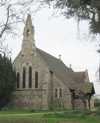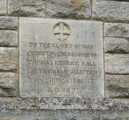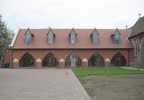 Aslockton Aslockton
St Thomas
History
The modern church of St Thomas, built in the 19th century, stands near the centre of the village, less than half a kilometre from the railway station. Between it and the station is the older heart of the village, including its two inns and post office. One of the houses there, however, is built on the remains of a much older building, the first chapel of Aslockton, built and destroyed centuries ago.
The first mention of the chapel, at that time a free chapel and dedicated to the Holy Trinity, was in 1147, when there was a dispute between Henry the Clerk, the chaplain of Aslockton, and William FitzWalter, who was the parson of the parish church of Whatton, the adjacent village. The dispute was regarding the nature of the relationship between the two churches and prompted a papal bull to be issued by Pope Clement II in 1147 which led to the chapel being tied to Whatton church. Whatton church was a possession of Welbeck Abbey so the abbey became the chapel's patrons until the Reformation.
Aslockton has a particular connection with the Reformation, as it was the birthplace of Thomas Cranmer, who rose to become the first protestant Archbishop of Canterbury. The Cranmer family had been local landowners for centuries and married into the Aslockton family around the same time. As a child Cranmer was educated by a local priest, either the parish priest at Whatton or the chaplain at Aslockton. Much later, he became a key advisor to King Henry VIII and was one of the chief architects of the English Reformation. His father, also Thomas, whose will was proved in 1501, left the sum of 6s 8d for the fabric of the chapel of the Holy Trinity of Aslockton.
Whatton church and Aslockton chapel, which at the time of the Dissolution was paying £2 10s per annum to Welbeck Abbey, were both sold to Thomas Cranmer himself in 1547 for £429 13s, likely as a gift from the King for his service. The two properties passed to his brother John and then to John’s son, also called Thomas. He in turn sold it on to Nicholas Rosell and Robert Brookesby. However it subsequently reverted to the Crown. At some point the chapel in Aslockton ceased to be a religious building and was converted into a dwelling house. In this state it was resold, either in 1571 or 1576, to John and William Mershe of London, who were also granted three acres of meadow land called Chapel Heades, which had previously been glebe land attached to the chapel.
Parts of the old chapel building, which became known as Cranmer’s Chapel, remained and were incorporated into newer constructions. The building was used mainly as a dwelling house although in 1792 it was apparently an alehouse, probably part of the Cranmer’s Arms inn, which still exists in the 21st century next door to the chapel building. Its status as a place for the consumption of alcohol clearly upset those antiquaries aware of its religious history. However it did not remain a drinking house and became once more a dwelling house, divided into several tenements. It also contained a mission room, where the villagers could come for worship if they wished.
For full services however, the villagers of Aslockton had to go to Whatton, where the parish church had remained, under the patronage of various individuals. The villagers were responsible for paying for one-third of the maintenance of the church, a legacy of the original ruling from the monks of Welbeck Abbey. However as they had no curate or chaplain of their own, they instead had the right to appoint a churchwarden to maintain their own interests, another traditional right dating back to the 12th century.
Then, in 1866 the village was detached from Aslockton and attached instead to the parish of Scarrington. This was partly because of the nearby river Smite, which sometimes overflowed its banks and cut Aslockton from Whatton, but also, according to reports, was mainly the work of the local lord of the manor. The villagers were outraged by the decision, which they had protested heavily. They had lost their traditional privileges with Whatton, which had frequently been a source of jealous rivalry with their neighbours, but which were also a great source of pride. However their protests were ignored and overruled and Aslockton remained with Scarrington for over 50 years.
Aslockton itself had by the late 19th century grown to be a large village of around 360 people - larger than both Whatton and Scarrington. It was certainly as deserving of a church as its two neighbours. But it was not until close to the end of the century that it finally received one, and in tragic circumstances. In February 1890 the Reverend Thomas Kenrick Hall, the vicar of Whatton, boarded the RMS Quetta in Australia. He was escorting his two nieces, Mary and Emily, to finishing school in England. However, a few days later the ship hit an uncharted rock while approaching Thursday Island, just off the northern coast of Australia. The ship sank, taking with it both the Reverend T K Hall and Mary. Emily survived for 36 hours in the water before being rescued and she returned to England bringing word of the tragedy.
In memory of her beloved son and local community leader, Mrs Sophia Hall of Whatton Manor decided to sponsor the construction of a new church, which became Aslockton St Thomas. The church was dedicated to St Thomas the Apostle, who had brought Christianity to southern India, but the choice was also to commemorate two local figures – Thomas Cranmer and Thomas Hall.
 Memorial stone to Memorial stone to
the Rev T K Hall |
The new church was designed by the architects Sir Arthur Blomfield and Sons, particularly Sir Reginald Bloomfield, and imitates the Early English style of the 12th and 13th century. It includes a nave, chancel, south aisle, organ chamber (with an organ designed by Brindley and Foster of Sheffield), and two vestries, all built of Ancaster stone, and could seat 200 people. Although lacking a tower, there was a bell gable, containing one bell. A memorial stone to the Rev T K Hall was placed beneath the east window in a small ceremony, and as part of which the villagers presented Mrs Hall with a silver trowel. In total the church cost £3,000 to build, paid for entirely by her. It was consecrated on 21 July 1892 by the Bishop of Southwell, George Ridding, who commented in the following year that it made a ‘model village example’.
The new church remained subordinate to Scarrington; its first vicar was the Rev John Standish BA, who had served Scarrington since 1885 and Scarrington’s patrons, the Dean and Chapter of Lincoln, were also the patrons of Aslockton. The church was quick to become a centre of communal activity – by 1912, when the church first made a visitation report to Bishop Hoskyns, it had a Sunday School with 45 pupils. There had been 8 baptisms and 2 confirmations in the previous year, demonstrating the villagers continuing devotion to their faith.
The enthusiasm for the new church was reflected in the gifts donated to it in the first few years of its existence. The Rev John Standish himself gave a mosaic pavement for the chancel, while other furniture was donated by locals of Whatton, Aslockton, and Scarrington. The pulpit was given by Mr John Innocent of Whatton, the lectern by Lady Walker and an altar cross was presented by Mr and Mrs Herbert Edlmann along with matching candlesticks from the Hall family.
In 1919 the church was detached from Scarrington and once again attached to Whatton. The separation occurred just after the end of the Reverend J. Standish’s time as vicar. A tablet was placed in the south wall of the chancel dedicated to him, looking out over the mosaic pavement he gave the church.
In 1965 the Cranmer Group was founded, a parish group consisting of six local churches, including those at Whatton, Scarrington, and Aslockton. The Group was of course named for Thomas Cranmer, although it is sometimes colloquially known as the ‘SO WHAT’ Group, after the first letter of the names of its churches.
In 1991, on the 100th anniversary of the church’s founding, the village held two weeks of celebrations. Many events looking at the village’s past and future were put on, as well as a flower festival and a special service held in the church, which was led by the Bishop of Southwell, Patrick Harris.
 Thomas Cramner Centre Thomas Cramner Centre |
A new community centre and village hall was built in 2010. Called the Thomas Cranmer Centre, it was built attached to the north side of the church, and contains kitchen and dining facilities for 100 people. Since its construction it has been used for local activities including night classes, plays and youth group meetings, as well as bigger affairs such as weddings and parties.
| 


 Memorial stone to
Memorial stone to Thomas Cramner Centre
Thomas Cramner Centre





